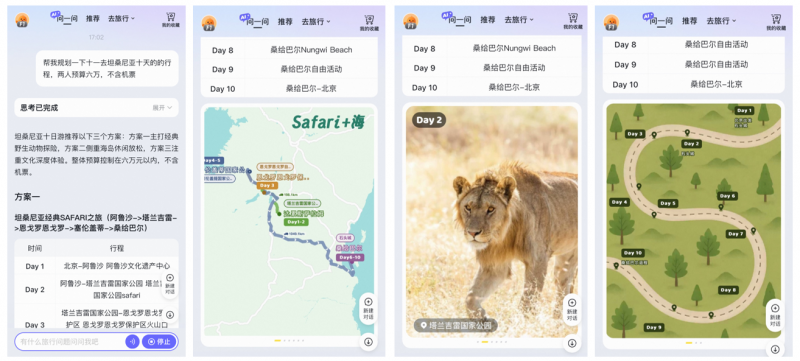
Less than one year ago, Chinese travelers were still skeptical about the applications of artificial intelligence (AI) for tourism. In Dragon Trail’s August 2024 survey of more than 1,000 Chinese travelers, just 5% said AI tools for travel had already helped them, and 90% either didn’t think it was useful or weren’t sure what to think.
But a lot has changed since then, and especially during the first months of 2025 – starting with the debut of DeepSeek’s chatbot in January. Now, China’s OTAs are all looking to enter this space, and travelers are starting to use these tools and discuss them online. Skift’s data highlights China as “a global leader in AI travel tool adoption,” ahead of the US and Europe.
Moreover, Chinese consumers are some of the most optimistic in the world about AI. Stanford University’s 2025 AI Index Report revealed China to be one of the countries where people were the most excited and least nervous about using AI tools.
This information was first shared at Dragon Trail’s June 2025 webinar on AI for Chinese Outbound Tourism. Click here to view the recording, with an in-depth discussion among industry experts. Contact us to request the presentation slides.
China’s OTAs Embrace AI
China’s OTAs and other online travel platforms have rushed to keep up with AI technology, with nearly all of them releasing or updating their own AI travel assistants in 2025.
• The Trip.com Group, which owns Ctrip and Qunar, was an early adopter, launching their TripGenie AI trip planning assistant back in 2023. TripGenie works with both text and voice commands to suggest personalized itineraries and find travel products. Recent developments include location-aware insights and a menu assistant.
• Fliggy’s new AI assistant is called AskMe or Wenyiwen, and was launched in April 2025. People are really talking about this one on RedNote/Xiaohongshu. It uses Alibaba’s own LLM and Fliggy’s pricing engine and data, and responds to both written and voice prompts, including Chinese slang and regional dialects. While most of the AI assistants introduced by OTAs so far are just basic chatbots, Fliggy’s is the most comprehensive tool so far, with extra features including budget controls and illustrated maps.
• Tongcheng’s AI China itinerary planner was launched in September 2024, and offers services in nine languages, with the inbound tourism market to China in mind as a target audience. This was the first OTA to integrate their AI assistant with DeepSeek, in late February 2025.
• Not to be left behind, OTA Tuniu launched their AI travel assistant Xiao Niu in April 2025, which uses both Alibaba’s Qwen and DeepSeek.
• Finally, travel website Mafengwo is rolling out localized AI travel assistants for destinations including Singapore and Guizhou. They also integrated with DeepSeek in February 2025.
Here are three areas where AI is already transforming Chinese tourism, as of June 2025:
1) Trip Planning
Trip planning is definitely the most developed and widely used application of AI for tourism in China so far. Consumers are already using these tools to help them plan and book their trips based on their individual needs. Some of the things that consumers like about these tools are not just the level of personalization and detail of the itineraries, but how these tools can help them to save time and money, and also using AI to generate visually pleasing, illustrated itineraries. Beyond just a list of places to visit, these planning tools can help give advice about weather and packing, up-to-date currency exchange information, and other helpful tips.

Results from Fliggy’s AskMe tool for a query about planning a 10-day trip to Tanzania
These itinerary building tools can also help Chinese travel agents and be used for B2B2C sales and marketing. Dragon Trail’s Trip Builder Pro platform connects AI chat tools with tourism boards’ own POI databases to generate fully customizable itineraries with information straight from the tourism board that’s all verified and up-to-date, with high-quality, free-to-use photos.
Click here for FAQs on Dragon Trail’s Trip Builder Pro AI tool
2) In-Destination
Another area where AI is already being used and has major potential is in destination.
AI can be used as a virtual tour guide and to provide information about local services, and there are attractions in China such as Huangshan Mountain, for example, that have linked up to DeepSeek to provide these services to visitors, where they can get up to date information about ticketing and suggested walking routes, as well as helpful practical information such as the location of the closest toilets.
As another example, Jimo Ancient City in Qingdao has autonomous driving vehicles, which also provide tourism information. And in the summer of 2024, the Shanghai Museum offered an AI guide for their exhibition on ancient Egypt, which went beyond an audio guide to also answer questions in multiple languages, using written or voice prompts.
Travelers have already been using translation and interpretation tools for quite some time now, and these are only going to get better. The Trip.com Group’s latest addition to their TripGenie tool, introduced at the end of last year, is a menu assistant that not only translates menus but also provides helpful information about what the dishes are and how they’re made.
A big part of the Chinese traveler’s digital journey is sharing their trip, and Dragon Trail’s latest consumer survey this spring revealed that 94% of outbound travelers share their travel experience on social media, with most posting at least once a day. Now, AI is also helping them to enhance their travel photos and create vlogs, which can then lead to even more sharing and more interaction with their shared content.
3) Marketing
You’ve probably seen the very popular Studio Ghibli AI tool and other AI design filters used to create social media marketing. China has its own trends and AI filters – one trend on RedNote this summer is an AI tool that creates videos where you can turn city landmarks into watermelon. RedNote users also use fun AI tools to create images that celebrate and inspire travel, such as images of suitcases or capsules that represent different cities in China and their unique charms.

LA Tourism AI video on RedNote, March 2025
Another big trend in China right now is related to Jellycat, the globally popular plush toy brand, which has done incredible localization and marketing in China, with pop ups like a vegetable market in Chengdu stocked entirely with plush toys of various vegetables, and a traditional Chinese-style apothecary in Shanghai, again featuring everything as a plush toy. This localization has been taken one step further by social media users, with the help of AI tools to generate images of anything – for example, regional Chinese cuisines – as Jellycat-style toys. A viral AI video tool released in February 2025 transforms city landmarks into Jellycat-style toys, and this was used by regional tourism boards as well as universities in China. At Dragon Trail, we picked up on this trend and created a video for Los Angeles Tourism & Convention Board’s RedNote and WeChat Channels accounts, featuring landmarks like the Santa Monica Pier and Hollywood film studios.
We’re looking forward to many more developments to come in AI for Chinese tourism, starting with updated Chinese consumer sentiment data from Dragon Trail Research on AI this September, as well as information on how the Chinese travel trade is using AI next month. Subscribe to our newsletter and follow us on LinkedIn to stay up to date.
Contact us for more information and a demo session on Dragon Trail’s Trip Builder Pro AI tool.
Sign up for our free newsletter to keep up to date on our latest news
We do not share your details with any third parties. View our privacy policy.
This website or its third party tools use cookies, which are necessary to its functioning and required to achieve the purposes illustrated in the cookie policy. If you want to know more or withdraw your consent to all or some of the cookies, please refer to the cookie policy. By closing this banner, scrolling this page, clicking a link or continuing to browse otherwise, you agree to the use of cookies.